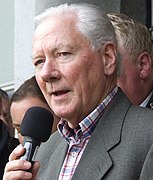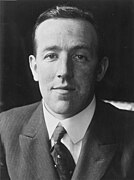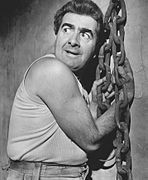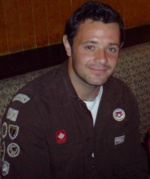Synge Street CBS
| Synge Street CBS Secondary School[1]
Sancta Maria CBS Primary School (Bunscoil na mBráithre Críostaí, Sráid Synge)[2] | |
|---|---|
 | |
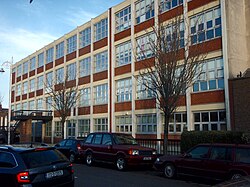 The St Pauls building on Heytesbury Street in Dublin, part of the school | |
| Location | |
 | |
Synge Street, Dublin D08 R283 | |
| Coordinates | 53°20′00″N 6°16′06″W / 53.3333°N 6.26833°W |
| Information | |
| Type | Voluntary secondary school (Edmund Rice Schools Trust (formerly Christian Brothers)) |
| Motto | "Viriliter Age" ("Act Manfully") |
| Religious affiliation(s) | Roman Catholic[3] |
| Founded | 1864; 161 years ago |
| Founder | Canon Edward McCabe Brother Edward O'Flaherty |
| Principal | (Secondary) Clare Catterson[3] |
| Gender | (Secondary) Boys,[3] (Primary) Mixed[2] |
| Age range | (Secondary) 12–19, (Primary) 4–12[1][2] |
| Enrollment | 363[3] |
| Colour(s) | Blue and White |
| Website | www |
Synge Street CBS[4] (colloquially Synger)[5][6] is a boys' non-fee-paying state school, under the auspices of the Edmund Rice Schools Trust, located in the Dublin 8 area of Dublin, Ireland. The school was founded in 1864 by Canon Edward McCabe and Brother Edward O'Flaherty,[7][8] as part of a mid-nineteenth century programme to expand the provision of Catholic schooling across the city, particularly for poorer boys. It was important in developing multiple new Christian Brothers schools in the local area and beyond.
Originally the school was part of the Christian Brothers monastery, but in 1954 new buildings were erected for primary pupils, and in 1964 for secondary pupils on Heytesbury Street. Although founded and largely known as an all-boys school, since 2016 it has offered co-educational Gaelscoil classes at primary level. While being the second-largest school in the country in the 1950s, the school roll has declined significantly since the turn of the millennium, and by 2021 had around 260 pupils at second level, and 100 at primary.[1][2]
The school has a long list of notable alumni in Irish political, business, media and sporting life, including both the President and Taoiseach of Ireland for a period of nearly two years in the mid-1970s, and is a status that has led to the school being described as the Eton of Ireland. It also has a strong record in the Young Scientist and Technology Exhibition becoming, in 2022, the first school to win the overall prize four times.[9]
History
[edit]
Mid-nineteenth century Ireland, and Dublin in particular, saw a major push for expansion of Catholic education.[10] Church officials were particularly keen to ensure there was provision for the poor and given societal perspectives of the time, this led to a focus on provision for poor boys. When Canon Edward McCabe was appointed as parish priest at St Nicholas parish in Francis Street, in the Liberties, it was probably inevitable that church institutions would expand in the area, after the successful struggle for Catholic emancipation in the 1820s and 1830s.[10]
In 1861, he secured a parcel of land between Synge Street and Heytesbury Street and built a temporary wooden church as the basis for a new neighbouring parish of Saint Kevin's. Between 1862 and 1864, he raised funding for and commissioned the building of the original monastery and school on the Synge Street side of the plot.[10]
McCabe's partner in these endeavours was Brother Edward O'Flaherty, a teacher at the Christian Brothers' Mill Street school.[11] O'Flaherty had taught James Aloysius Hoare at Mill Street in the 1820s, and it was more than fortuitous that Hoare was appointed as the third Superior General of the order in 1862.
The first school opened on 12 April 1864,[12] with O'Flaherty as the first Superior, and the first pupil enrolled was Paul McSwiney, son of the Lord Mayor of Dublin, Peter Paul McSwiney.[12] Very quickly the number on roll reached its limit at 600 pupils with 10 Christian Brothers employed teaching them.[8]
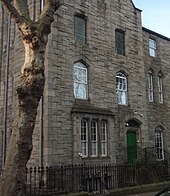
The school building was extended four times over the next half century culminating with the purchase and demolition of three cottages at Nos. 13–15 Synge Street and extending the school building into the space.[8] In 1931, a gaelscoil was opened in premises at Harcourt Street by brothers from the school community.[13] Called Coláiste Mhuire, the school in 1933 moved to the Gaelic League headquarters on Parnell Square and ceased to be managed from Synge Street.[13]
In 1925 the school affiliated to the newly created Irish Free State's Programme for National Schools,[14] and has continued to provide education free of charge since then.[3]
The school is known as "Synger" colloquially.[15]
The new secondary school has been officially known as St Paul's Secondary School, Heytesbury Street. The present building replaced a row of houses, used for class-rooms, and was opened by the Minister of Education Donogh O'Malley in January 1967, and blessed by John Charles McQuaid.[16] It was extended in the 1980s.[7]
School roll
[edit]Having started with 600 on the roll in 1864, by 1963 the roll had expanded to 1500.[17] A profile in the Irish Times in 1953 described the school as the second largest in the country.[18]
The roll size has collapsed in recent years,[19] due to changes in local demographics; in 2010 the school saw its roll fall by 11% over 2004 figures.[20] But it is still seen to be a very viable school,[21] and in 2015 had been part of the Delivering Equality in Schools (DEIS) programme for the past 20 years.[22]
Primary schools
[edit]In 1930 a new primary school was opened at Donore Avenue to the west, under the patronage of the Brothers at Synge Street.[8] This was followed in 1947 by the building of Scoil Iosagáin Primary School, again under Synge Street's patronage, to the south at Aughavanna Road in Dolphin's Barn,[8] and by the opening, in 1954,[23] of the new Sancta Maria CBS primary to the north of the current school on Synge Street. In 1961, a new primary was opened at Francis Street, replacing an earlier 1846 building, under the patronage of the school's Christian Brothers community.[24]

In 2017 Bunscoil Sancta Maria changed its enrolment policy to accept boys and girls at Junior Infant level to be educated via the medium of Irish.[25] The existing enrolment of boys at 2nd class remains.[25] This Irish stream was the first-ever 'sruth' established at primary level in Ireland.
School site and buildings
[edit]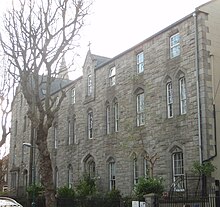
The school, at its greatest extent, covered most of the area delimited by Heytesbury Street, Grantham Street, Synge Street and Harrington Street in Dublin 8. The other major building on this block is St Kevin's Church, which had very strong links with the school, providing a venue for most school-related religious celebrations.[citation needed]
There are two main school buildings, St Pauls Secondary School facing onto Heytesbury Street, and Sancta Maria Primary School on Synge Street. The third large building on the site now hosts the Lantern Centre, a community intercultural venue,[26] although it was the original school building and Christian Brothers monastery.[10] St Pauls was built in the 1960s and extended in the 1980s.[27] It contains three science labs, an art room, and a library, as well as the classrooms. It hosts the school PE hall which is also used for drama productions and featured in the film Sing Street.[27]
Curriculum
[edit]The school educates to Leaving Certificate and runs a transition year.[28] It has been perceived to be a traditionally academic school.[29] Gay Byrne has indicated in his era that the prime driver of the school was for the boys to pass their exams.[30]
In September 2024, it was announced that the school would be moving to a co-educational basis, and all-Irish education. It later became known that this was only notified to the principal, and then staff, the day before public announcement, the actual decision having been made by the Edmund Rice Schools Trust with the approval of the Minister for Education.[31] Many staff are not trained to teach other subjects through Irish,[citation needed] and much of the student body has a diverse national or ethnical background, and some sources suggest that many pupils will have to move school as a result.[32]
Drama and the arts
[edit]The school has a long history[33] of drama productions including The Plough and the Stars and The Risen People.[34] Records for an "Annual Concert" go back to 1893.[35] When St Pauls was built in the 1960s it included a large fully equipped theatre which was used to produce drama productions right from the beginning.[16]
Sports
[edit]As with most non-fee-paying Christian Brothers schools, the sporting focus of the school was in gaelic games, to the point that other sports, especially soccer, were actively discouraged.[36] But activities such as athletics,[37] water polo,[38] golf[39] swimming[40] and chess were tolerated and even encouraged.
Gaelic football
[edit]Football and hurling were the school's two traditional sports throughout the 20th century.[41][42] The school produced numerous successful teams, including Dublin and Leinster Colleges Champions in 1964 at Under 15, a team that included Don Givens,[43] while the school contested three out of six Leinster Colleges hurling and football finals in 1956.[24] The Leinster Junior Cup winning team of 1965 comprised the core of the 1967 Leinster Senior Cup finalists, including one Anton O'Toole in both teams.[44]
Synge Street Past Pupils Gaelic Football Club
[edit]Until 1999, past pupils of the school played together in a unique club – Synge Street Past Pupils GFC. The club would only register players who had formerly been pupils at the school. In 1999 the club merged with Templeogue GFC to form Templeogue Synge Street GFC.[45]
The club own their own grounds at Dolphin Park, in Dolphins Barn. This ground was originally the Dolphin Racing Track and was purchased by the Christian Brothers in 1943, as playing fields for the school, with a total area of 15 acres,[46] but were subsequently sold to the club in the 1990s.[citation needed]
Soccer
[edit]The school has a very strong soccer tradition[47] producing many great players including Ireland internationals Billy Whelan (one of the Busby Babes who died in the Munich air disaster), Tommy Hamilton (the Shamrock Rovers stalwart) and Andy Reid.[48][49]
The school fielded its first competitive soccer team in 1975,[50] and won its first soccer trophy – the Leinster Junior School's Cup – in 1977,[51] and until recently[when?] had a very strong under 18's soccer team winning Leinster Trophies and representing the school in many tournaments including the Schools World Cup[52] in Israel, which Synge Street represented Ireland in 1993.[53] They finished the competition in sixth place and took the fair play award.[53]
Hurling
[edit]The school also has a strong hurling tradition with teams reaching many Dublin and Leinster finals at all levels.[54]
Kevin's Hurling club, also based in Dolphin's Barn, is independent of the school, being originally set up for Saint Kevin's Parish.[55] But its association with the school goes back to the turn of the 20th century. In 1934 Sylvestor Muldowney, a past pupil of the school, became one of the few Dublin natives to represent his county in an All-Ireland hurling final.[55]
Young Scientist Exhibition
[edit]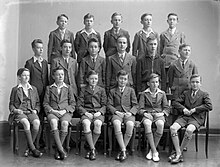
The school has one of the best success rates[57] in the Young Scientist competition and one of their science teachers, Jim Cooke, was considered one of the best science teachers in Ireland, receiving many awards in his field.[58] The school has won the overall contest of the BT Young Scientist competition on four occasions, the only school to ever do so.[15]
The first outright winner from the school was 5th-year student Ronan Larkin in 2004, having won a category prize the previous year, which then paved the way into a remarkable decade of success.[58] His winning project was entitled 'Generalised Continued Fractions'.[59] The winner in 2007 was Somalia-born Abdusalam Abubakar, a 3rd year student, who became one of the youngest winners of the BT Young Scientist of the Year Award and later went on to win the EU Contest for Young Scientists for his project, which was entitled An Extension of Wiener's Attack on RSA.[60]
In 2009, Andrei Triffo won the Intel Travel Award,[61] the fourth individual honour award for Synge Street in a five year period. As well as Triffo, a group consisting of Gary Carr, Graham McGrath and Darragh Moriarty also claimed a prize in the Chemical, Physical and Mathematical Intermediate category.[62] This was followed in 2012, when Leaving Cert students Eric Doyle and Mark Kelly won the overall prize and represented Ireland in the European Union Contest for Young Scientists competition in September 2012 in Bratislava, where they were awarded 1st place in Physics, and joint overall first place.[63]
In 2017, the school won 3 awards, including both 1st and 2nd Place in the Junior Group category, where Carl Jones and Keiron O'Neill won with a project on Generalisations of Feynman's Triangle Theorem.[64] In 2022, Junior Cert students Aditya Joshi, aged 15, and Aditya Kumar, aged 16, took home the top prize for their project entitled "A New Method of Solving the Bernoulli Quadrisection Problem".[65]
The first ever Young Scientist Exhibition was held in the Mansion House, Dublin in 1965: 230 students participated and 5,000 people attended. One of the co-founders was Fr. Tom Burke who was himself a past pupil, from the class of 1941.[66]
Honours list
[edit]- 2022 – Aditya Joshi and Aditya Kumar took home the top prize for their project entitled "A New Method of Solving the Bernoulli Quadrisection Problem"[67]
- 2021 – Yaduvir Harhangi and Marton Goz – Senior Group Winners and Trinity College Global Challenges Award[68]
- 2020 – Yaduvir Harhangi – Intermediate Individual Winner[69]
- 2018 – Yaduvir Harhangi – Junior Individual Winner[70]
- 2017 – Carl Jones and Keiron O'Neill – Junior Group Winners[64]
- 2016 – Gabriel Barat and Adrian Wolniak – Group Runners-up[71][72] and Intel Travel Award Winners[citation needed]
- 2014 – Sufyan Huma and Haider Hussain – Intel Travel Award[73][74]
- 2012 – Mark Kelly and Eric Doyle – Overall Winner.[75]
- 2009 – Andrei Triffo – Best Individual Award and Intel Travel Award[76][77][78]
- 2007 – Abdusalam Abubakar – Overall Winner.[79][80]
- 2006 – Keith Florea, Adrian Chisa and Sandeep Sihag – Group Winners[81]
- 2006 – Gohar Abbasi – Overall Runner Up[82]
- 2005 – Michael Mulhall and Francis Wasser – Group Winners.[83][84]
- 2005 – Louie Placides, Haniel Tsegburhan, Stefan Triffo – Junior group Category winners – Chemical, Physical and Mathematical Sciences[83]
- 2005 – Gohar Abbasi – Senior individual Category winner – Chemical, Physical and Mathematical Sciences[83]
- 2004 – Ronan Larkin – Overall Winner[85]
- 2003 – Ronan Larkin – Category Prize[58]
Notable teaching staff
[edit]As well as Jim Cooke, other notable past teachers of the school include Francis MacManus, three of whose pupils James Plunkett, Pearse Hutchinson and John Jordan, went on to be famous writers.[86] Former TD Tony Gregory taught at the school in the 1960s and 70s.[87]
List of Superiors
[edit]This article is missing information about Superiors at Synge Street. (December 2020) |
Traditionally, the Christian Brothers appointed a Brother Superior to head each monastery and manage any attached schools. This is a list of those known to have held the post at Synge Street:[8]
- 1864–1867 Bro E P O'Flaherty
- 1867–1873 Bro H A Joy
- 1873–1876 Bro T R Ring
- 1876–1889 Bro P B O'Brien
- 1889–1894 Bro B L O'Neill
- 1894–1901 Bro W M O'Callaghan
- 1901–1903 Bro R B Fleming
- 1903–1905 Bro D D Madigan
- 1905–1913 Bro J T Hayes
- 1913–1919 Bro J A Burgess
- 1919–1923 Bro T J Stapleton
- 1923–1928 Bro J A Burgess
- 1928–1930 Bro T M Lennane
- 1930–1936 Bro J L Burke
- 1936–1942 Bro E F Lonergan
- 1942–1948 Bro P S Walsh
- 1948–1954 Bro J K Mulhall
- 1954–1956 Bro J F Dowling
- 1956–1962 Bro M F O'Mahoney
- 1962–1968 Bro J D Fegan
- 1968–1972 Bro F B Donovan
- 1973–1976 Bro P Tynan
- 1977–1982 Bro P B Cripps
Notable past pupils
[edit]Media and the arts
[edit]- Eamonn Andrews, television presenter[88]
- Noel Andrews, RTÉ boxing commentator[48]
- Deaglán de Bréadún, Irish Times journalist[89]
- Gay Byrne, television and radio presenter[90]
- John Carney, film director[91]
- Don Cockburn, newsreader[92]
- John Connolly, author[93][94]
- Donal Donnelly, actor[95]
- John Earle, musician[96]
- Louis Elliman, past owner of the Gaiety Theatre and Theatre Royal[97]
- Charles B. Fitzsimons, actor, and brother of Maureen O'Hara[98]
- Jarlath Hayes, graphic designer and typographer[99]
- Kieran Hickey, film director[100]
- Pearse Hutchinson, poet[101][102]
- John Jordan, poet[103]
- Charles E. Kelly, cartoonist[104]
- David Kelly, actor[98][105]
- Peter Lennon, director of the film Rocky Road to Dublin[106]
- Patrick Joseph McCall, poet and songwriter[107]
- Hugh McFadden, poet[103]
- Jack MacGowran, actor[108]
- Eamon Morrissey, actor[109]
- Mike Murphy, broadcaster[110]
- Jim Norton, actor[111]
- Dennis O'Dea, actor[112]
- Brian O'Nolan, who wrote under the pseudonym Flann O'Brien[113]
- Kieran O'Reilly, actor and musician[114]
- Cathal Ó Sándair, Irish language author[115]
- Milo O'Shea, actor[116]
- Seán O'Sullivan RHA, painter and designer of Irish Stamps[117]
- Basil Payne, poet[118]
- James Plunkett, writer[119]
- Cornelius Ryan, writer[120]
- Pete St. John, Irish folk singer-songwriter[121]
- Cecil Sheridan, comedian[122]
- Niall Stokes, publisher of Hot Press magazine[123]
- Patrick Swift, painter[124]
- Derek Warfield, founder of the Wolfe Tones[125][126]
- Richard Weber, poet and artist[127]
Politics and public service
[edit]- David Andrews, Fianna Fail TD[42]
- Niall Andrews, Fianna Fail TD[128]
- Todd Andrews, republican activist, public servant, and father to 2 TDs[129]
- Joseph Barnes, doctor[130]
- Harry Boland, Irish Volunteer,[131] his brother Gerald also hurled for the first Kevin's Hurling club team[55]
- John Boland, Fine Gael politician and government minister[132]
- Rory Brady, former Attorney General of Ireland[133]
- Tom Burke, priest, educator and founder of the Young Scientists[56]
- Eric Byrne, Irish Labour Party TD[134]
- Seán Campbell, senator and trade union leader[135]
- Desmond Clarke, academic[136]
- Jim Cooke, teacher and mentor to Young Scientists[58]
- Liam Cosgrave, politician[137]
- John Crown, Senator and consultant oncologist.[87]
- Robert Dudley Edwards, historian[138]
- Joseph Finnegan, judge[139]
- Paddy Finucane, Second World War fighter pilot[140]
- Thomas Gay, republican and librarian[141]
- Michael Hayes, first Ceann Comhairle of Dáil Éireann[142]
- William Hayes, President of St John's College, Oxford, 1987–2001[143]
- Daire Keogh, Irish historian, President of St Patrick's College, Drumcondra, later President of Dublin City University[144][145]
- Liam Lawlor, politician[146][147]
- Con Lehane, republican activist[148]
- Liam Lysaght, chief state solicitor and President of the Leinster Branch of IRFU[149]
- Dermot McCarthy, senior civil servant[150]
- Thomas McLaughlin, designer of the Shannon hydroelectric scheme[18]
- John Moore SMA, Bishop of Bauchi[151]
- Kevin Murphy, career civil servant, Ombudsman and Information Commissioner[152]
- Aindrias Ó Caoimh, Judge of the High Court[48]
- Charlie O'Connor, Fianna Fáil TD[153][154]
- Cearbhall Ó Dálaigh, former President of Ireland[155]
- Cillian Ryan, professor and economist[156]
- Richie Ryan, politician[157]
- James Sanfey, Fine Gael General Secretary[158]
- Michael Woods, politician[159]
Sport
[edit]- Paddy Andrews, footballer[160]
- John Coady, footballer[51]
- Joe Doyle, cyclist and national official[citation needed]
- Don Givens, footballer[49][161]
- Tommy Hamilton, footballer[162]
- Eddie Jordan, motor racing boss[163]
- Paddy Lowry, Olympic sprinter[164]
- David McGill, former professional footballer[165]
- Donnacha O'Dea, professional poker player & Olympic swimmer[166]
- Kevin O'Flanagan, rugby and soccer international, Olympics administrator and doctor[167]
- Anton O'Toole, footballer[49]
- Andy Reid, footballer[49]
- Col Billy Ringrose, army officer and equestrian[168]
- Liam Whelan, footballer and Busby babe[125]
- Thomas Williams, cricketer[169]
-
Gay Byrne
-
Andy Reid
Motto
[edit]The school motto is "Viriliter Age" (translated "Act Manfully") and is a standard used by many Christian Brothers' schools throughout the world.[170]
Religion
[edit]As a Christian Brothers school, the school has always had a strong Roman Catholic ethos. This includes a long history of having its own fraternity of the Society of Saint Vincent de Paul,[171] as well as prayers before each class.[42] The teaching of religion was considered to be important not only to the school and pupils, but also to the state.[172]
Reputation
[edit]The school has garnered an enviable reputation, particularly in relation to its notable alumni,[42][173] even being compared to Eton College in relation to Irish public service.[42] At one point both the President of Ireland and the Taoiseach who served him, Cearbhall Ó Dálaigh and Liam Cosgrave respectively, were both past pupils,[173] as well as the Minister for Finance and Garda Commissioner.[42] The Taoiseach, Seán Lemass praised the school as "... a Dublin institution of which all Dublin men were aware and proud..." at the school's centenary dinner in 1967.[174] Lemass's Dail colleague, Cosgrave opined, at a Synge Street Past Pupils Union dinner, that "No Christian Brothers' school had a better record than Synge Street, and the numerous past pupils ... who had achieved eminence in different walks of life, was an indication of the high standard of education provided".[175]
Its illustrious alumni list is no accident. The school always had a reputation for high educational standards and exam results.[42] Students have achieved first place in the Leaving Certificate in subjects such as physics, chemistry and Irish, amongst others.[176]
Synge Street students regularly excelled in events such as the Father Mathew Feis,[177] winning and placing in multiple awards year after year. As early as 1907, three of the scholarships offered by the diocese of Dublin were awarded to Synge Street students.[178] Senior boys have been invited to contribute to current affairs programmes on RTÉ Television, and complimented on the lucidity of their contributions.[179] Students also excelled at chess, with the school regularly placing in the upper parts of the Leinster Schools Chess competitions.[180]
Students are encouraged to move on to third-level education by the school, and financial assistance is available from a charitable bequest by a now-deceased former pupil.[15] In 2012, 83% of Leaving Certificate students at the school progressed to further or higher education courses.[15]
The school also had a reputation for the overuse of corporal punishment, with one pupil receiving 75 slaps of the leather for one offence.[181]
Past Pupils Union
[edit]The school has a very active alumni organisation, Synge Street Past Pupils Union, which was formed in 1933.[182] The PPU hosts an annual alumni dinner and raises money to provides grants to the school.[citation needed]
Additionally, it helps administer a trust setup by a former past-pupil – Con Creedon – which provides grants to past pupils entering third-level education.[183] When the programme began in 2006, it distributed grants to just 3 students, while by 2014 the number had grown to 82.[22] This has helped raise the proportion of leaving cert students transitioning to third-level to 78% in 2014.[citation needed]
Abuse allegations
[edit]In 2005, a Brother at the school, Dan Doheny, was tried on charges of abuse which was alleged to have occurred when he was teaching at St Joseph's Industrial School, Tralee 30 years previously.[184]
In 2020, a former teacher at the primary school, Patrick Harte, was convicted of multiple indecent assault charges relating back to the 1960s and 1970s at the school.[185] His appeal was subsequently dismissed by the Court of Criminal Appeal. Father Dominic Boland, a Capuchin priest who was a chaplain to the primary school was also convicted of similar offences and was named in chapter 32 of the Dublin diocesan Murphy report.[citation needed]
Popular culture
[edit]The 1990s teen musical series Finbar's Class was filmed in the school.[186]
John Carney, a past pupil of the school, set his 2016 feature film Sing Street in and around the school. The film's protagonist, Conor/Cosmo, attends the school, forming a band with schoolmates and coming into conflict with the fictional Christian Brother school principal.[187] The film's production notes make clear that the school and persons portrayed in the film are very different from the school as it is today.[188]
References
[edit]- ^ a b c "School Detail – Christian Brothers, Synge St". Department of Education and Skills. Retrieved 22 January 2021.
- ^ a b c d "School Detail – Sancta Maria C B S". Department of Education and Skills. Retrieved 22 January 2021.
- ^ a b c d e "School Detail". Department of Education and Skills. Retrieved 24 November 2020.
- ^ Keenan, Mark (24 January 2020). "Movie Magic: 'Synge Street' house on sale for €630,000". independent. Irish Independent. Retrieved 29 September 2020.
- ^ de Bréadún, Deaglán (25 August 2016). "'Synger' – An Irishman's Diary on Synge Street CBS in the Sixties". Irish Times. Retrieved 21 February 2021.
- ^ Cusack, Danny (6 September 2016). "Synge Street Christian Brothers School". Tinteán. Retrieved 21 February 2021.
- ^ a b "School History". Synge Street CBS. Archived from the original on 16 July 2011. Retrieved 31 January 2009.
- ^ a b c d e f Synge Street CBS 1864–1964 Centenary Record. CBS Synge Street. 1964. p. 28.
- ^ O'Sullivan, Kevin. "Dublin students declared BT Young Scientists of the Year for 2022". The Irish Times. Retrieved 14 June 2022.
- ^ a b c d Synge Street CBS 1864–1964 Centenary Record. CBS Synge Street. 1964. p. 20.
- ^ Synge Street CBS 1864–1964 Centenary Record. CBS Synge Street. 1964. p. 22.
- ^ a b Synge Street CBS 1864–1964 Centenary Record. CBS Synge Street. 1964. p. 26.
- ^ a b Synge Street CBS 1864–1964 Centenary Record. CBS Synge Street. 1964. p. 79.
- ^ Synge Street CBS 1864–1964 Centenary Record. CBS Synge Street. 1964. p. 71.
- ^ a b c d Faller, Grainne (24 January 2012). "Synge Street – where did it all go right?". Irish Times. Retrieved 25 January 2012.
- ^ a b "Minister opens C.B.S. £140,000 wing". Irish Times. 26 January 1967. Retrieved 12 December 2020.
- ^ "Synge street to celebrate centenary". The Irish Times. 8 November 1963. p. 14. Retrieved 12 December 2020.
- ^ a b "One school was not enough". Irish Times. 16 June 1956. Retrieved 12 December 2020.
- ^ Flynn, Grainne Fallersean. "One fifth of those at university paid second-level fees". The Irish Times. Retrieved 10 December 2020.
- ^ "School numbers: who has more pupils and who has less?". The Irish Times. Retrieved 10 December 2020.
- ^ "Well of saints and scholars: The model school without a waiting list". The Irish Times. Retrieved 10 December 2020.
- ^ a b "High profile Synge Street principal bows out". Catholicireland.net. 11 August 2015. Retrieved 22 January 2021.
- ^ "History". Archived from the original on 28 July 2014.
- ^ a b Synge Street CBS 1864–1964 Centenary Record. CBS Synge Street. 1964. p. 109.
- ^ a b "Irish Language". Aontú. Retrieved 29 September 2020.
- ^ "The Lantern Intercultural Centre". Retrieved 11 December 2020.
- ^ a b "Facilities". Synge Street CBS. Retrieved 11 December 2020.
- ^ "Young people are social innovators". The Irish Times. Retrieved 10 December 2020.
- ^ "It's not the time to lose your sense of humour". The Irish Times. Retrieved 10 December 2020.
- ^ Healy, Yvonne. "Gay Byrne tells his time with the Christian Brothers in Synge Street". The Irish Times. Retrieved 12 December 2020.
- ^ Kelly, Emma O. (13 September 2024). "Sudden announcement to switch school to Gaelcholáiste". RTE.
Since Tuesday staff at the school have been reeling from the news. For some, it means they must leave the school as they do not have the language skills required to teach through the medium of Irish. One staff member described it as like being in mourning. Staff and others connected to the school are concerned about the impact the decision to become an Irish medium school will have on local families traditionally served by Synge Street. These include lower income families who live in the inner city, and also immigrant families who send their both first and second generation boys to the school. They fear the change will drive these families away.
- ^ Nolan, Larissa (14 September 2024). "'Synge Street going as Gaeilge will push inner-city kids out'". Dublin Live. Retrieved 16 September 2024.
- ^ "Schoolboy Actors". britishpathe.com. Retrieved 11 December 2020.
- ^ "Cast of 32 in youth theatre production". Irish Times. 16 August 1984. Retrieved 10 December 2020.
- ^ "The Christian Brothers School Synge Street". Irish Times. 11 January 1893. Retrieved 12 December 2020.
- ^ Oireachtas, Houses of the (25 February 2015). "Joint Committee on Foreign Affairs and Trade debate – Wednesday, 25 Feb 2015". oireachtas.ie. Retrieved 11 December 2020.
- ^ "Synge street C.B.S. Sports". Irish Times. 25 June 1956. Retrieved 10 December 2020.
- ^ "Schools Water Polo". Irish Times. 11 November 1955. Retrieved 10 December 2020.
- ^ "Over 40 schools in foursome event". Irish Times. 24 April 1984. Retrieved 10 December 2020.
- ^ "Interviews – Sporting Legends of Ireland Donnacha O'Dea". Turtle Bunbury. Retrieved 11 December 2020.
- ^ Pocock, Iva (5 August 2004). "Cricket enjoys run of success". Irish Times. Retrieved 14 June 2022.
- ^ a b c d e f g Murphy, Christina (26 September 1978). "We say the Hail Mary before every class". Irish Times. Retrieved 10 December 2020.
- ^ Synge Street CBS 1864–1964 Centenary Record. CBS Synge Street. 1964. p. 110.
- ^ "Synge Street in final proper". Irish Times. 30 November 1967. Retrieved 10 December 2020.
- ^ "Club History". Templeogue Synge Street GFC. Archived from the original on 17 February 2009. Retrieved 17 February 2009.
- ^ Synge Street CBS 1864–1964 Centenary Record. CBS Synge Street. 1964. p. 97.
- ^ "'Streets taught us how to play ball' – Reid believes south Dublin zone left stamp on players". herald. Evening Herald. Retrieved 29 September 2020.
- ^ a b c PPU Union Who's who Archived 2011-07-16 at the Wayback Machine
- ^ a b c d "Well Travelled". Independent Newspapers. 17 February 2009. Retrieved 17 February 2009.
- ^ "Synge Street's debut in schools tourney". Irish Times. 18 May 1976. Retrieved 10 December 2020.
- ^ a b "Hoops Heroes: John Coady". Archived from the original on 10 January 2015.
- ^ "Technical Rules for ISF WSC Football" (PDF). International School Sport Federation. Retrieved 24 November 2020.
- ^ a b "World Schools Championship Football". ISF. Retrieved 25 September 2020.
- ^ "Brunswick Street qualify again". Irish Times. 25 October 1973. Retrieved 10 December 2020.
- ^ a b c "Home – Team Site". kevins.ie.
- ^ a b "Committed educator and Young Scientist Exhibition founder". The Irish Times. Retrieved 25 September 2020.
- ^ Horn, Chris (27 January 2012). "The tech sector is buoyant, exports are strong, there is a skills shortage, so where are the young scientists". Irish Times. Retrieved 10 December 2020.
- ^ a b c d Ahlstrom, Dick. "End of an era at Synge Street as mentor of successful Young Scientists retires". The Irish Times. Retrieved 25 September 2020.
- ^ "Photos 2000s – BT Young Scientist and Technology Exhibition Archive". archive.btyoungscientist.com. BT Young Scientist. Retrieved 29 September 2020.
- ^ "EU Contest for Young Scientists – Valencia 2007 – Press Centre: prize winners". European Union. Archived from the original on 21 May 2008. Retrieved 17 February 2009.
- ^ "Synge Street Student Scoops Top Intel Prize at YSTE". Intel. 22 January 2009. Retrieved 17 February 2009.
- ^ "Fairy tale ending to Young Scientist Exhibition". Archived from the original on 10 February 2015.
- ^ "Two Irish students win EU young scientist award". RTÉ.ie. 25 September 2012.
- ^ a b "Category Awards 2017". BT Young Scientist. Archived from the original on 18 January 2017. Retrieved 17 January 2017.
- ^ El-Hassany, Reem (14 January 2022). "Dublin students take top prize at BT Young Scientist". RTÉ.ie. Retrieved 22 March 2024.
- ^ "Fr Patrick (Thomas) Burke, O.Carm. (1923–2008)". The Carmelites. Archived from the original on 16 October 2010. Retrieved 17 February 2009.
- ^ al-Hassany, Reem (14 January 2022). "Dublin students take top prize at BT Young Scientist". RTE. Retrieved 14 January 2022.
- ^ "Category Winners". Irish Times. Retrieved 2 February 2021.
- ^ "Category Winners". Irish Times. Retrieved 2 February 2021.
- ^ "Category Winners". Irish Times. Retrieved 2 February 2021.
- ^ Ahlstrom, Dick. "Balbriggan pair named Young Scientists of the Year". The Irish Times. Retrieved 29 January 2021.
- ^ "Balbriggan students win BT Young Scientist award". RTÉ.ie. 8 January 2016.
- ^ "Special Awards". The Irish Times. 11 January 2014. Retrieved 2 February 2021.
- ^ "Twitter". mobile.twitter.com.
- ^ "Dublin Students win Young Scientists 2012". RTÉ.ie. 13 January 2012. Archived from the original on 15 January 2012.
- ^ "4 Top Awards". The Irish Times. Retrieved 25 September 2020.
- ^ Ahlstrom, Dick. "Kinsale boys named top young scientists". The Irish Times. Retrieved 25 September 2020.
- ^ "2009 winner". Archived from the original on 26 January 2009.
- ^ "2007 winner". Archived from the original on 3 July 2007.
- ^ "2007 winner". RTÉ.ie. 12 January 2007.
- ^ "2006 Group Winners". Archived from the original on 18 May 2013.
- ^ "2006 Runner Up". RTÉ News. 14 January 2006.
- ^ a b c Ahlstrom, Dick (15 January 2005). "New Language for the Web scoops Young scientist award". Irish Times. Retrieved 10 December 2020.
- ^ "Intel awards physics/chemistry/mathematics prize at the Young Scientist and Technology Exhibition in Ireland". Intel. Retrieved 17 February 2009.
- ^ "Esat Young Scientist named". RTÉ.ie. 11 January 2004. Retrieved 17 February 2009.
- ^ McGovern, Avice-Claire (July 2010). "Collection List No. 162 Francis MacManus Papers" (PDF). National Library of Ireland. p. 3. Retrieved 12 July 2014.
- ^ a b Gilligan, Robbie (2011). "Chapter 1". Tony Gregory: The Biography of a True Irish Political Legend. O'Brien. p. 30. ISBN 978-1-84717-226-6.
- ^ "Eamonn Andrews Biography presenter of This Is Your Life, Crackerjack and What's My Line". UtterTrivia. Archived from the original on 28 December 2005. Retrieved 17 February 2009.
- ^ "Irish Times Appointments". Irish Times. 4 February 1997. Retrieved 10 December 2020.
- ^ Dwyer, Ciara (7 December 2008). "Waking hours – Gay Byrne". Independent Newspapers. Retrieved 17 February 2009.
- ^ Clarke, Donald. "John Carney goes urban musical Once more". The Irish Times. Retrieved 15 December 2020.
- ^ "Shy newsreader who was one of Ireland's best-known faces". The Irish Times. Retrieved 12 December 2020.
- ^ "Master of the grisly murder scene". The Irish Times. Retrieved 10 December 2020.
- ^ "John Connolly". ricorso.net.
- ^ "Donal Donnelly". The Scotsman. Retrieved 17 August 2013.
- ^ "Versatile and highly-rated musician who supported some of the greats". The Irish Times. Retrieved 10 December 2020.
- ^ Harris, Nick (2002). Dublin's Little Jerusalem. Dublin: A. & A. Farmar. p. 80. ISBN 978-1-899047-90-1.
- ^ a b Linehan, Fergus. "Devine intervention". The Irish Times. Retrieved 15 December 2020.
- ^ "Master typographer and designer". Irish Times. 16 June 2001. Retrieved 9 March 2021.
- ^ Gillespie, Elgy (16 December 1980). "Love in a cool climate". Irish Times. Retrieved 10 December 2020.
- ^ "Pearse Hutchinson, Fanatics and Philistines". RTÉ Archives. Retrieved 14 January 2016.
- ^ "CoisLife: Pearse Hutchinson". Cois Life. Archived from the original on 19 November 2007. Retrieved 17 February 2009.
- ^ a b "John Jordan". Ricorso. Retrieved 17 February 2009.
- ^ "Dictionary of Irish Biography – Cambridge University Press". dib.cambridge.org. Cambridge University Press. Retrieved 4 January 2021.
- ^ "Actor who breathed life into the weird and wonderful". The Irish Times. Retrieved 15 December 2020.
- ^ "Journalist and director of 'Rocky Road to Dublin'". Irish Times. 26 March 2011. Retrieved 11 September 2011.
- ^ Maye, Brian. "Pulse of the Bard – An Irishman's Diary on poet and songwriter PJ McCall". The Irish Times. Retrieved 10 December 2020.
- ^ Battersby, Eileen (9 November 1988). "Jack MacGowran: Born to play Beckett". Irish Times. Retrieved 15 December 2020.
- ^ "Interview with Eamon Morrissey". Archived from the original on 3 January 2012. Retrieved 17 April 2012.
- ^ Nolan, Larissa. "Why one of Ireland's most famous schools is going Gaelscoil". The Irish Times. Retrieved 24 November 2020.
- ^ Wallace, Arminta. "The Times We Lived In: Scrubbed up on Synge Street". The Irish Times. Retrieved 15 December 2020.
- ^ Butler, John. "Having sharks for breakfast". The Irish Times. Retrieved 29 September 2020.
- ^ "The Early Years of Brian O'Nolan, Flann O'Brien, Myles na gCopaleen by Ciaran O'Nuallain: Book Cover * The Early Years of Brian O'Nolan, Flann O'Brien, Myles na gCopaleen". Barnes and Noble. Retrieved 17 February 2009.
- ^ O'Reilly, Kieran. "Actor/Musician".
- ^ "Cathal Ó Sándair Exhibition". Cork City Libraries. 2022. p. 3. Retrieved 24 July 2023.
- ^ "Milo O'Shea". The Daily Telegraph. 3 April 2013. Retrieved 7 May 2020.
- ^ "Dictionary of Irish Biography – Cambridge University Press". dib.cambridge.org. Retrieved 24 November 2020.
- ^ "Poet and writer prized on world stage". The Irish Times. Retrieved 10 December 2020.
- ^ Maume, Patrick (June 2010). "Plunkett, James". Dictionary of Irish Biography. DIB.ie. doi:10.3318/dib.009331.v1. Retrieved 30 July 2021.
- ^ "Dublin Writers; Born Here, Lived Here, Wished we were here" (PDF). Archived from the original (PDF) on 5 April 2012.
- ^ "Pete St. John". Pete St. John. Retrieved 17 February 2009.
- ^ "Death of Cecil Sheridan". Irish Times. 5 January 1980. Retrieved 15 December 2020.
- ^ Ford, Richard; Naughton, Philippe (17 April 2005). "Interview: Daire O'Brien: Hey man, Hot Press is still with it after all these years – Times Online". The Times. London. Archived from the original on 12 June 2011. Retrieved 17 February 2009.
- ^ "The Fall and Rise of Patrick Swift". Irish Times. 11 June 1992. Retrieved 15 December 2020.
- ^ a b Hall, Seán. "The Real Synge Street – Ireland's Own". Irelands Own. Retrieved 18 December 2020.
- ^ Madigan, Tom. "Why Aer Lingus Pulled the Plug – Q&A With Singer Derek Warfield – The Wild Geese Today". The Wild Geese. Archived from the original on 17 August 2003. Retrieved 17 February 2009.
- ^ "Richard Weber: An acclaimed Irish poet who suddenly went silent". The Irish Times. Retrieved 10 December 2020.
- ^ "Politician who championed Third World issues". The Irish Times. Retrieved 10 December 2020.
- ^ McCarthy, John P. (2006). Ireland: A Reference Guide From The Renaissance To The Present. Facts on File, Inc. pp. 184–185. ISBN 978-0-8160-5378-0.
- ^ England, Mary (12 June 2017). "Joseph Barnes: An Appreciation". Irish Times.
- ^ Maher, Jim (1998). Harry Boland: A Biography (PDF). Dublin: Mercier Press. p. 6. ISBN 978-1-85635-236-9. Retrieved 15 December 2020.
- ^ "Innovative and dynamic former Fine Gael minister". Irish Times. 19 August 2000. Retrieved 28 March 2016.
- ^ "Rory Brady – Independent.ie". 25 July 2010.
- ^ Tynan, Maol Muire (11 June 1994). "Persistence finally pays off for the dogged Eric Byrne". Irish Times. Retrieved 10 December 2020.
- ^ Dempsey, Pauric J. "Campbell, John Patrick". Dictionary of Irish Biography. Retrieved 1 March 2024.
- ^ "Desmond M Clarke: Fearless philosopher and distinguished scholar". The Irish Times. Retrieved 29 January 2021.
- ^ MchCormack, W. J.; Gillan, Patrick (2001). The Blackwell Companion to Modern Irish Culture. p 554: Blackwell Publishing. pp. 686. ISBN 978-0-631-22817-2.
{{cite book}}: CS1 maint: location (link) - ^ O'Day, Alan (11 June 2014). Longman Handbook of Modern Irish History Since 1800. Routledge. ISBN 978-1-317-89710-1 – via Google Books.
- ^ "Five now in the running to become new chief justice – Independent.ie". 16 July 2004.
- ^ "Finucane, Brendan Eamonn ('Paddy')". Dictionary of Irish Biography. Retrieved 6 October 2022.
- ^ "Dictionary of Irish Biography – Cambridge University Press". dib.cambridge.org. Cambridge University Press. Retrieved 4 January 2021.
- ^ McI, M (12 July 1976). "First Speaker of the Dail dies". Irish Times. Retrieved 10 December 2020.
- ^ Anon (2020). "Hayes, William". Who's Who. A & C Black. doi:10.1093/ww/9780199540884.013.U19585. (Subscription or UK public library membership required.)
- ^ Mac Donald, Sarah (5 May 2014). "Synge Street school celebrates 150th anniversary". CatholicIreland.net. Retrieved 20 July 2020.
...Daire Keogh, President of St Patrick's College Drumcondra, left Synge Street in 1982. "... had an enrolment of 750 students. "... end of an era; we were the last group ... to have Brothers teaching us in the school.
- ^ "DCU Home – DCU" (PDF). spd.dcu.ie. Archived from the original (PDF) on 14 March 2014.
- ^ "Liam Lawlor: a life in the public eye". The Irish Times. 24 October 2005. Retrieved 2 February 2021.
- ^ "Liam Lawlor dies in Moscow taxi crash. – Indymedia Ireland". 22 October 2005. Retrieved 17 February 2009.
- ^ "Dictionary of Irish Biography – Cambridge University Press". dib.cambridge.org. Cambridge University Press. Retrieved 4 January 2021.
- ^ "Public servant with the law on his side". The Irish Times. Retrieved 18 February 2016.
- ^ de Bréadún, Deaglán (7 February 2009). "The Great Facilitator". Irish Times. Retrieved 10 December 2020.
- ^ "Biography of Bishop John Moore SMA". Society of African Missions. 20 January 2010. Retrieved 7 April 2016.
- ^ "Irish Journal of Public Policy: IJPP Obituaries". publish.ucc.ie.
- ^ "Dáil debates Thursday, 11 March 2010 What are Dáil debates? Report of Joint Committee on the Constitutional Amendment on Children: Statements (Resumed)". Kildare Street. Retrieved 14 January 2016.
- ^ "Charlie O'Connor". Fianna Fáil. Archived from the original on 19 November 2007. Retrieved 17 February 2009.
- ^ "Cearbhall O Dalaigh". UCD. Retrieved 17 February 2009.
- ^ Class Lists
- ^ "UCD Archive – Richie Ryan".
- ^ "Cosgrave's diligent, right-hand man". Irish Times. 15 April 2000. Retrieved 28 March 2016.
- ^ "Michael Woods". Fianna Fáil. Archived from the original on 19 November 2007. Retrieved 17 February 2009.
- ^ Reid, Tony (20 November 1981). "Paddy Andrews – great all-rounder". Irish Times. Retrieved 10 December 2020.
- ^ Ryan, Sean. "Honour for Don.(Sport)". Archived from the original on 23 October 2012. Retrieved 17 February 2009.
- ^ "When Busby's Babes came to Dalymount: 60 years on from when Shamrock Rovers clashed with the mighty Man United". Independent.ie. Retrieved 1 May 2019.
- ^ Rodden, Mark. "Getting seriously revved up about the big occasions". The Irish Times. Retrieved 15 December 2020.
- ^ Mercator (1 July 1985). "How an Olympic promise was fulfilled – from a sick bed". Irish Times. Retrieved 10 December 2020.
- ^ "UC Santa Barbara". UC Santa Barbara.
- ^ Butler, John. "Having sharks for breakfast". The Irish Times.
- ^ "Dictionary of Irish Biography – Cambridge University Press". dib.cambridge.org. Cambridge University Press. Retrieved 4 January 2021.
- ^ "Military man regarded equestrian success as a discharge of duty". Irish Times. 30 May 2020. Retrieved 10 December 2020.
- ^ "Player profile: Thomas Christopher Williams". CricketEurope. Retrieved 1 November 2018.
- ^ "Trinity College History". Trinity College. Archived from the original on 23 July 2008. Retrieved 17 February 2009.
- ^ "60th Anniversary of Society of St Vincent de Paul". Irish Times. 22 March 1999.
- ^ "Education in some States "like body without soul"". Irish Times. 7 February 1956. Retrieved 12 December 2020.
- ^ a b Hall, Seán. "The Real Synge Street – Ireland's Own". Ireland's Own. Retrieved 29 September 2020.
- ^ "Lemass praises Synge Street School". Irish Times. 17 April 1964. Retrieved 12 December 2020.
- ^ "Investment needed in secondary education". Irish Times. 22 February 1963. Retrieved 12 December 2020.
- ^ "Irish attend Science meeting". Irish Times. 30 July 1980. Retrieved 10 December 2020.
- ^ "Father Mathew Feis Awards". Irish Times. 26 April 1935. Retrieved 10 December 2020.
- ^ "Intermediate Education Act". 14 December 1907. Retrieved 12 December 2020.
- ^ Grey, Ken (19 April 1976). "Self-Examination". Irish Times. Retrieved 10 December 2020.
- ^ Walsh, J.J. (22 May 1979). "League results". Irish Times. Retrieved 10 December 2020.
- ^ Watt, Nicholas (16 April 1997). "Christian Brothers offer public apology to abused pupils". The Times. No. 65865. Times Newspapers Ltd.
- ^ "Synge Street Christian Schools first reunion dinner". Irish Times. 23 February 1933. Retrieved 12 December 2020.
- ^ "New Beginnings: September 2016 – August 2017". Synge Street C.B.S Past Pupils Union. 10 August 2018. Retrieved 29 December 2020.
- ^ "Brother denies sex abuse charges". independent. 27 January 2005. Retrieved 10 December 2020.
- ^ Brennan, Declan (12 July 2020). "Remorseless to the end: the Synge Street abuser who refused to repent". independent. Irish Independent. Retrieved 29 September 2020.
- ^ "RTÉ Archives". 5 July 2012.
- ^ Bradshaw, Peter (19 May 2016). "Sing Street review – pitch perfect Commitments-style school of rock". The Guardian. Guardian Newspapers. Retrieved 31 May 2016.
- ^ Saldana, Selena. "Sing Street Production Notes UK Final" (PDF). Retrieved 31 May 2016.
External links
[edit]- 1864 establishments in Ireland
- Boys' schools in the Republic of Ireland
- Catholic primary schools in the Republic of Ireland
- Congregation of Christian Brothers secondary schools in the Republic of Ireland
- Educational institutions established in 1864
- Primary schools in Dublin (city)
- Secondary schools in Dublin (city)
- Synge Street school
- Young Scientist and Technology Exhibition


